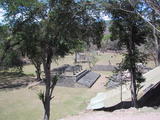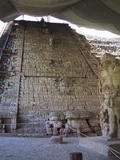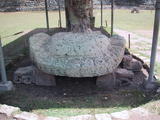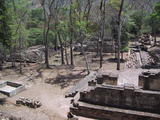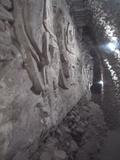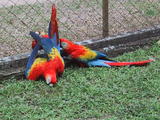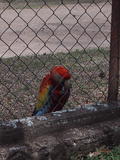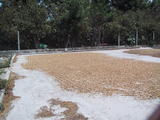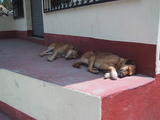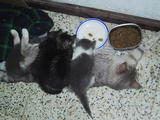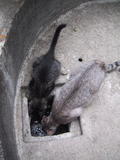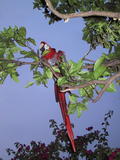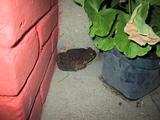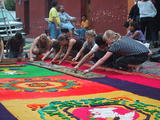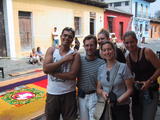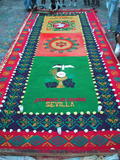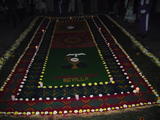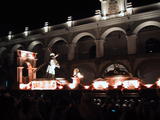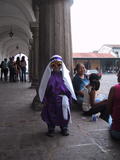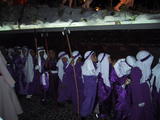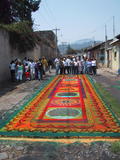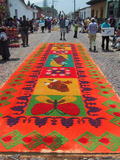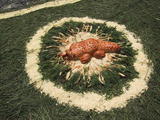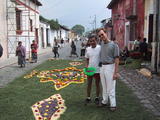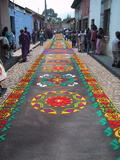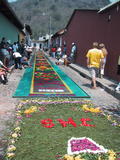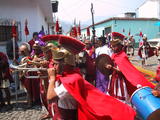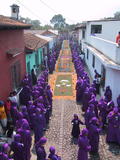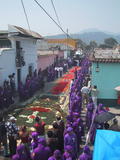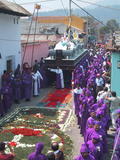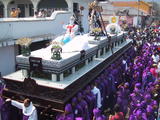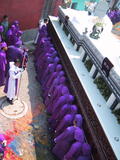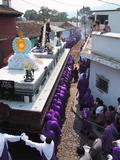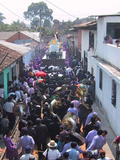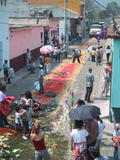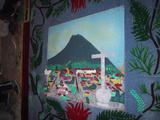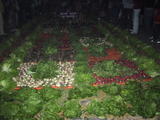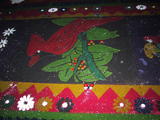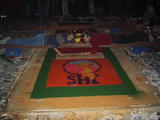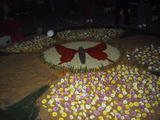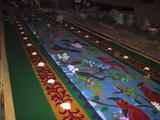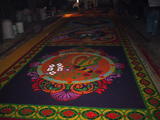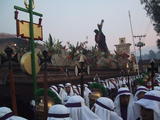| < < < Previous story | Next story > > > | |
Copan, Atitlan's flower power colony and Semana Santa in AntiguaAntigua Guatemala, 4 May 2003
Contents:Back in GuatemalaWe left Livingston, by taking the boat up the Rio Dulce to a town with the same name, a beautiful river with great scenery and lots of birds. Unfortunately we could not take any pictures because the camera was still drying up from the water bottle related incident that had occurred in Livingston. The same day we continued by bus to Chiquimula. The bus driver, as did several other people before and after, asked us if we were Americans. After divulging our nationalities (Dutch and Estonian) they generally seem to find it necessary to inform us of their hatred of all Americans. Since they are on the subject of who they hate this is sometimes followed by the revelation that they also hate gays. In fact violence against gays, is common in Guatemala, if it becomes known that someone is gay, he may be chased out of town or even lynched. Many of them seem to find a safe haven in Antigua, where the atmosphere is a little more tolerant. Another social issue in Guatemala is the lower social status of indigenous people. They rarely have good jobs, and their children don't go to school as often as those of Latino descent. This was the root cause of the civil war that ended with the 1996 peace treaty. The former rebels known as the ex-PAC, are supposed to receive certain payments under this agreement. Apparently this had not happened, so while the teacher strike had ended just after we left Guatemala, it was now the turn of the ex-PAC rebels to block roads just as we returned to Guatemala. We made it to Chiquimula without any problems however, unlike some other travelers, and stayed there for two nights, not that there is anything to do there, except as we did, to visit Copan, just across the border in Honduras. Upon our arrival in Chiquimula I put the battery of the digital camera in the charger, after 10 or 15 minutes I tried to turn on the camera and nothing happened. Maybe the camera was really broken or the battery was broken or the battery was as empty as it can be because of the contact with water that it needed to be charged much longer. We decided to let it charge all night. In the morning I placed the battery in the camera, and the impossible happened, it turned on! On the screen was a single complaint: no CF card. So I put the memory card in, and all the pictures where still there! Great! We couldn't believe our luck. We still had all our pictures and we could take pictures of the Copan ruins as well. CopanThe Maya ruins in Copan have been partially destroyed by the adjacent river many years ago, but most of it still remains to be admired. The river has since been diverted to flow further from the ruins and the ruins have been fortified. Archaeologists have dug tunnels through some of the structures, revealing previous structures. Apparently the Mayas built structures upon previous structures every 52 years (a cycle in the Mayan calendar). Our guide gave us an account of all the kings, I lost track, but remember king 18 Rabbit. Rabbits you see where holly animals just like jaguars and snakes. One of the things Copan is famous for is a stairway with the entire history of Copan written on it in Mayan glyphs. Unfortunately some archaeologist restored the stairs, without taking care to replace each stone in its proper location losing invaluable information in the process. We left Chiquimula again by bus (2.5 Euros for 170 km) for Guatemala City. Buses in Guatemala are definitively a lot cheaper than in Mexico or Belize. For only a couple of Euros you can travel hundreds of kilometers. The roads are not bad, and most even have all the lines painted on them, though these seem to be just for decoration. Once in Guatemala City we urgently needed to find an ATM since we had run out of cash, and not a single ATM had accepted our bank cards since Mexico. In Chiquimula it was even impossible to get a cash advance on a Mastercard, which in Belize at least was not a problem. After trying every ATM in Guatemala City we could find in an hour, we finally found an ATM belonging to the Pronto network of Credomatic that accepted bank cards with the Maestro logo. This ended the cash crisis. Lago AtitlanWith enough cash in our pockets we continued our journey to Lago Atitlan (Lake Atitlan). With the last boat we crossed the lake to our destination San Pedro La Laguna. It turned out we traveled back in time at least 30 years on that boat. In San Pedro flower power still rules. We were told that marijuana is the second local product after coffee! San Pedro is also the cheapest place we have traveled to, the most expensive hotel room, cost 60 Quetzal (7 EUR) per night and was clean and had a private shower. Travelers here are very relaxed and very much cut off from the rest of the world, by the way they walk around they do not seem to have any pressing purpose. For as much as Antigua sometimes looks like a Dutch colony, San Pedro is dominated by Israelis. Semana SantaReturning to Antigua, strangely felt like coming home. We returned to the house where we had stayed before our so-called Maya tour. We had already reserved the room before we left since Semana Santa is a very busy week. It was nice to meet our friends again. Fleur was now also staying in the same house as us and Curt has gotten his first tattoo (he told us it was very painful). The week before Easter is called the Semana Santa (Holy Week). During this week they commemorate each day a different part of the story that ends with the crucifixion and resurrection of Jesus. Processions leave the churches and continue in the streets for hours and hours. Up to 60 people carry on their shoulders podium like displays with large statues of Christ carrying a cross and other decorations. I can't say these displays were really beautiful, actually they struck me as being pretty ugly. They also looked extremely heavy, turns out people actually have to pay for the privilege of carrying these podiums around a block or two. In contrast what was beautiful to see were the alfombras (carpets). For hours people would be patiently making these carpets, from flours and/or painted sawdust, in the streets where the processions would pass. Only to see their beautiful alfombras being destroyed by the passing procession, sometimes only minutes after being completed! During the night of Thursday to Friday the alfombra making reached it's peak, people would stay up all night to make them all over Antigua. We stayed up the whole night with our friends, and went on an excursion at 04:00 (4 a.m.) to see all these beautiful alfombras. If you want to be notified when we write more about our trip, just send us an E-mail. e-mail Otto de Voogd PhotosCopanLago AtitlanHouse PetsSemana Santa in Antigua GuatemalaPractical Information
To my knowledge the information provided here was accurate
at the time of our visit. However time passes and things can change.
Money(ATMs for Maestro/Cirrus bankcards) Guatemala: Only Credomatic ATMs. The locations of their ATMs are listed on their site. Only US Dollars can be exchanged, Euros are not accepted. CostsHonduras
Copan ruins entry fee: 8 USD (from memory).
Guatemala - Quetzal, approx. rates: 1 USD = 7.80 GTQ, 1 EUR = 8.50 GTQ
Bus: Chiquimula to Guatemala City: 20 GTQ
| ||
| < < < Previous story | Next story > > > | |
New | About | Contact | Connect | Friends | Promotions | Copyright | Advertise
